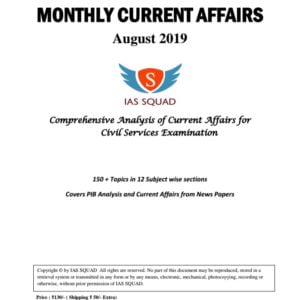Daily Current Affairs for UPSC CSE
Topics Covered
- School Education Quality Index
- Palaeochannels
- Fiscal Responsibility and Budget Management Act (FRBM)
- Pandit Jasraj
- Starship
- Impact of Corporate Tax cut
1 . School Education Quality Index
Context : There are huge differences in the quality of school education across the country, according to a Niti Aayog ranking released on Monday. Among 20 large States, Kerala was the best performer with a score of 76.6%, while Uttar Pradesh came in last with a score of 36.4%.
About the Index
- School Education Quality Index (SEQI) was developed by NITI Aayog to evaluate the performance of States and Union Territories (UTs) in the school education sector.
- The index aims to bring an ‘outcomes’ focus to education policy by providing States and UTs with a platform to identify their strengths and weaknesses and undertake requisite course corrections or policy interventions.
- In line with NITI Aayog’s mandate to foster the spirit of competitive and cooperative federalism, SEQI strives to facilitate the sharing of knowledge and best practices across States and UTs. Developed through a collaborative process, including key stakeholders such as Ministry of Human Resource and Development (MHRD), the World Bank and sector experts, the index consists of 30 critical indicators that assess the delivery of quality education.
- These indicators are categorized as below:
- Category 1: Outcomes
- Domain 1: Learning outcomes
- Domain 2: Access outcomes
- Domain 3: Infrastructure and facilities for outcomes
- Domain 4: Equity outcomes
- Category 2: Governance processes aiding outcomes
- Category 1: Outcomes
- To facilitate a like-for-like comparison, States and UTs have been grouped as Large States, Small States and UTs. Within each of these groups, the indicator values have been appropriately scaled, normalized and weighted to generate an overall performance score and ranking for each State and UT.
- States and UTs are ranked on their overall performance in the reference year 2016-17, as well as on their annual incremental performance (difference in the overall performance) between the reference year and base year (2015-16).
Importance
- Schooling should result in successful learning outcomes. A credible system of assessment in this regard is crucial to design necessary remedial actions.
- To ensure the system is geared towards learning, SEQI assigns almost half its weight to learning outcomes.
- This sends a strong signal across the nation to ensure the focus remains centred on learning outcomes.
- The rankings present incredible insights on the status of school education across States/UTs and their relative progress over time.
Ranking of States
- Larger States – 1) Kerala 2) Rajasthan 3) Karnataka
- Small States – 1) Manipur, 2) Tripura 3) Goa
- Union Territories – 1) Chandigarh 2) Dadra & Nagar Haveli 3) Puducherry
2 . Palaeochannels
Context : The Union Water Ministry has excavated an old, dried-up river in Prayagraj (formerly Allahabad) that linked the Ganga and Yamuna rivers. The aim is to develop it as a potential groundwater recharge source, according to officials at the National Mission for Clean Ganga (NMCG), a body under the Union Jal Shakti Ministry that coordinates the cleaning of the Ganga.
About Palaeochannels
- A palaeochannel, or paleochannel, is a remnant of an inactive river or stream channel that has been filled or buried by younger sediment
Details of the excavation
- It was a “buried paleochannel that joins the Yamuna river at Durgapur village, about 26 km south of the current Ganga-Yamuna confluence at Prayagraj.
- Knowledge on subsurface connectivity between Ganga and Yamuna rivers will play a very crucial role in planning of Ganga cleaning and protecting safe groundwater resources
3 . Fiscal Responsibility and Budget Management Act (FRBM)
Context : States’ gross fiscal deficit (GFD) has remained within the Fiscal Responsibility and Budget Management Act (FRBM) threshold of 3% of gross domestic product (GDP) during 2017-18 and 2018-19, a Reserve Bank of India report on State Finances said.
About FRBM Act
- Fiscal Responsibility and Budget Management (FRBM) Act enacted in 2003 by the Indian parliament aims at bringing financial discipline on government expenditure.
- Aimed primarily to bring a check on revenue deficit, the act strives to improve the overall management of public finance by controlling unchecked borrowings and imparting financial discipline.
- When it was introduced for the first time, its target was to bring down the fiscal deficit to 3 percent of the GDP by 2008.
- However, the act suffered several challenges, such as the global financial crisis of 2007, when it came to implementation due to several reasons.
- On more than one occasion, the target planned to be achieved was relaxed or time frame was extended.
NK Singh Committee
- A committee was set up under NK Singh in 2016 to review the act.
- The committee on its part recommended that the government should target a fiscal deficit that is 3 percent of the GDP by 2020 and bring it down to 2.5 percent by 2023
Details of the Report
- “States’ gross fiscal deficit (GFD) has remained within the FRBM threshold of 3 per cent of gross domestic product (GDP) during 2017-18 and 2018-19. This has, however, been achieved by sharp retrenchment in expenditures, in particular, capital expenditure.
- For 2019-20, states have budgeted for a consolidated GFD of 2.6 per cent of GDP with a marginal revenue surplus (as against revenue deficits in the previous three years)
- The report said sharp reduction in capital expenditure by states has potentially adverse implications for the pace and quality of economic development, given the large welfare effects of a much wider interface with the lives of people at the federal level.
- “Currently, states employ about five times more people and spend around one and a half times more than the Centre. Moreover, public expenditure by states influences the quality of physical and social capital infrastructure of the economy
- “States’ revenue prospects are confronted with low tax buoyancies, shrinking revenue autonomy under the GST framework and unpredictability associated with transfers of IGST and grants.
4 . Pandit Jasraj
Context : A minor planet between the orbits of Mars and Jupiter has been named after the legendary vocalist Pandit Jasraj.
What is a ‘minor planet’?
- Minor planets are celestial objects orbiting the Sun that are not large enough for their gravity to pull them into a spherical shape.
- This distinguishes a minor planet — or a “small Solar System body”, which is now the preferred term — from planets or “dwarf planets”, which are almost spherical.
- Small Solar System bodies include asteroids, comets, and several other celestial objects that go around the Sun.
How are they named?
- Names of celestial bodies are finally approved by a committee at the International Astronomical Union (IAU), a global organisation of professional astronomers, which also decides on definitions of fundamental astronomical and physical constants.
- In the case of small Solar System bodies, the discoverer has the privilege to suggest the name. The discoverer holds this privilege for 10 years since the discovery. But there is a process to be followed, and not all names are acceptable.
- Once it is determined that a celestial body is indeed new, a provisional name is given. This name has the year of discovery, two letters of the alphabet and, perhaps, two numbers.
- The minor planet that has been named after Pandit Jasraj was initially called ‘2006VP32’.
- Once more information is available about the body, particularly its orbit, and after it has been sighted on at least four occasions, it is entitled to have a permanent number. In this case, the number allotted was 300128. Only after this is the discoverer invited to suggest a name.
What are the requirements of the name?
- There are rules for nomenclature, and restrictions on the names that can be suggested. The proposed name must have 16 characters or less, it must be “non-offensive”, and not too similar to an existing name.
- Names of political or military leaders can be suggested only 100 years after their death.
- The same applies for a political or military event. Names of pets, and names of a commercial nature are “discouraged”.
- There can be restrictions depending on where the body is located — for example, new objects discovered beyond Neptune are supposed to be given names of creation deities
About Pandit Jasraj
- Pandit Jasraj is an Indian classical vocalist, belonging to the Mewati gharana
- He is a recepient of Padma Vibhushan
- Pandit Jasraj is the 1st Indian Musician, to join the galaxy of immortal composers such as Mozart, Beethoven and Tenor Luciano Pavarotti.
5 . Starship
About Starship
- Starship is a prototype design of its next-generation spacecraft that will take people or cargo to the moon, Mars or other destinations in space or around Earth.
- Starship will allow us to inhabit other worlds to make life as we know it multiplanetary, starship has been designed for full, “rapid reusability”.
- SpaceX’s Starship spacecraft will be capable of carrying up to 100 people on long-duration interplanetary flights and deliver as much as around 100 tons of payload for building bases on Moon and Mars cities.
- Starship will be the most powerful rocket in history, capable of carrying humans to the Moon, Mars, and beyond. Starship is expected to reach orbit in six months
6 . Impact of Corporate Tax cut
The cut has three broad impacts.
- In the immediate term, it leaves corporates with more money, which they can use to either reinvest in existing firms or invest in new ventures if they think doing so would be profitable. But it is also possible that they may simply use this money to pay off old debts or pay higher dividends to their shareholders. Whether or not companies invest will depend on the prevailing economic conditions.
- Investments crucially depend on the consumption levels in an economy. If there is high consumer demand for, say, cars, firms in that sector would happily invest — but if there is no demand for, say, chocolates, firms in that sector would not invest. However, if the consumption level is depressed because incomes are low across the board, and companies have high unsold inventories (cars and chocolates, etc.), the impact on fresh investments would be muted.
- In the medium to long term, that is anywhere between one or two and five years or more, a corporate tax cut is expected to boost investments and increase the productive capacity of the economy. That’s because regardless of a slump in demand in the short term, investment decisions are taken after considering long term demand projections. If demand is expected to grow, investments will bear fruit and with lowers taxes, profits will be higher. These investments will also create jobs and increased earnings in due course.
- However, a corporate tax cut also depresses economic activity to the extent that it reduces the money in the hands of the government in the form of tax revenues. If this money had been with the government, it would have been spent on either paying salaries or creating new productive assets such as roads — either way, this money would have gone straight to the consumers, instead of the investors.


